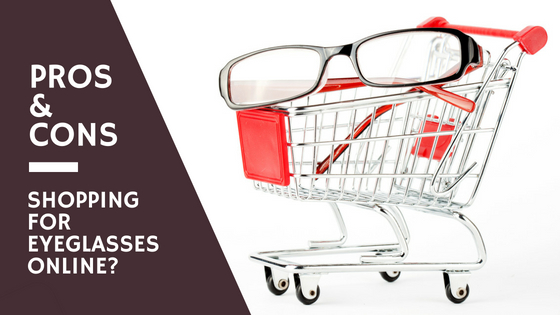Pros and Cons of Buying Prescription Eyeglasses Online

Online shopping has taken a lot of hassle out of our daily lives. Perhaps the thought of buying your next pair of prescription eyeglasses online might even sound appealing.
You wouldn’t have to deal with a crowded shopping area or long lines when you got to the optician’s office. So let’s take a look at some of the pros and cons of ordering prescription eyeglasses via the internet.
Pros:
- The biggest advantage to buying online is the cost. It is possible that online shopping could save you up 40% of the total cost of new eyeglasses.
- You can search through several websites and have your pick of thousands of frames.
- Once you’ve made your decision, insert all the required details about your eyes and method of payment, and that’s it.
Cons:
- You need to accurately measure the distance between your pupils, which is extremely difficult to do.
- Online services cannot test for eye health.
- The frames will not be adjusted to fit your head and face when purchased online.
- Progressive lenses and bifocals have too many variables in the prescription, so it is not advisable to order them without professional assistance.
An investment in your health
Although eyeglasses frames come in a vast variety of colours, styles and sizes, purchasing a pair of prescription eyeglasses should be much more than a fashion statement. You certainly want to find a pair of frames that look good on you, so going into the optician and trying the frames on is a wise idea.
You also need to find out if the frames work well with the lenses you’ve chosen. A small frame could make you look very interesting, but your prescription might not fit into such small lenses. You’ll get a warped, fish-eye view if the frames you choose are curved or wrap-around and your prescription has to be made into a curved lens. There are limits. It would also be a good idea to think about getting anti-glare and anti-scratch coatings for your lenses, but you may need to talk to an optician to know which options are best.
Seek out an optician
Buying prescription eyeglasses is a serious investment. For instance, if you try to measure the pupil distance yourself, a small mistake could end up causing eye strain and headaches. An optician can tell you if the frames and lenses are a good fit for each other and you.
Not only will an optician make the initial measurements, but will also adjust your eyeglasses once they arrive. When there is a need, you can take your prescription eyeglasses in for an adjustment. You can’t do that over the internet!
For excellent, professional service from a well-trained local optician, contact Eye World today to set up an appointment. We invite you to give us a call at 902-465-4979 or submit the sidebar form on this page to get priority booking. We look forward to discussing your eyeglasses needs with you.
Stop Squinting & Save Your Eyes with Prescription Sunglasses

If you’re squinting in the sun because you bought those drugstore fit-over sunglasses or cheap clip-ons then you’re likely causing damage to your eyes and vision.
You may know that sunglasses protect your eyes against the sun’s UV rays. But have you ever considered that not all sunglasses give you the good protection? You can find thousands of glasses in department stores which claim to “block UV rays.”
To save your vision from serious damage choose sunglasses that offer 100% protection from UV rays. With cheap sunglasses, you may find that you’re still squinting and straining to see.
Whether you need prescription sunglasses or not, consider investing in high-quality sunglasses that will save your eyes from serious damage.
UV Protection
Ultraviolet rays from the sun will weaken your eyes. It can also hurt your eyelids. UV rays can bring on the development of cataracts and macular degeneration.
To protect your eyes from damaging UV rays, ask for prescription sunglasses that block 99-100% of UVA and UVB rays. You should request lenses that protect your eyes from 75-90% of all visible light.
Polarized Lenses versus Transition Lenses
Both of these lens-types are practical for your eyes. Polarized lenses eliminate the glare reflected from light sources onto all surfaces like water, snow and ice, the light that comes through your windshield or that bounces off the hood of your car.
A problem that can occur with polarized lenses is the filter that protects against glare can also block your ability to read certain electronic lights including some dashboard lights and your cell phone. It can prove dangerous if you don’t see a patch of ice your about to drive over or cannot read your car’s speedometer.
Transition lenses turn dark when you’re outside, so they save you the trouble of needing a second pair of prescription glasses.
A problem some people experience with them is that it takes one or two minutes before they to return to clear lenses when you go indoors. A bigger difficulty is when a car’s windshield blocks UV light from getting into the car, it will also keep the transition lenses from becoming dark.
Tinted Lenses
Coloured lenses can be much more than a fashion statement. Each colour can reduce glare, improve your ability to see contrasts, strengthen a person’s depth perception and reduce eye fatigue in various surroundings.
Tinted lenses can benefit the athlete and improve their performance in many sporting events.
Lens Coatings
When you’re looking for new sunglasses, think about the different coatings that are available.
A scratch-resistant coating will extend the life of your glasses and give you clearer vision.
Glare-resistant lenses will reduce your tendency to squint and strain your eyes due to the glare from oncoming car headlights, computer screens and other electrical devices.
A UV Protective coating will keep your eyelids from sunburn and protect your eye’s structure. This coating is crucial in saving your eyes from UV’s damaging rays.
Consider a Larger Frame
Even with good lenses, light from the sun can still reach your eyes in any place the frame doesn’t touch your face. Choosing a larger frame, thus, larger lenses will keep more of your eyes protected.
Buying glasses online might seem like a great deal. But if you have anything other than basic vision needs it might be a waste of time and money.
Not all prescriptions will work with every eyeglass frame. Making it a challenge to find a pair of sunglasses that will work with your prescription.
For some prescriptions, if the frame you like has a curve, the corrective focal point on your lense won’t be in that sweet spot. Things will look distorted.
Ask the dispensing optician at your eye doctor’s office for advice. They are the experts on eyeglass frame design, fit and corrective lenses. They’ll not only help you choose an attractive frame to suit your face shape, and lifestyle but they’ll know if the frames you picked will work for your specific prescription.
If you have vision questions or would like to make an appointment, please contact us at Eye World. Give us a call at 902-465-4979 or submit the online form on this page to get the next available eye exam appointment.
Bifocal vs Progressive Eyeglasses – Which Is Right For Your Vision?
Your eyesight can blur as you get older. This change in your vision is caused by the loss of elasticity of the lens. This is known as presbyopia; it is commonly associated with the aging process, typically appearing after the age of 40.
Your Vision Needs May be More Complex
As you age, you could learn that you need one prescription for near vision and an entirely different prescription to see clearly at a distance. You can accommodate both prescriptions with one pair of glasses by selecting bifocal or progressive lenses. To make an informed decision, you may need to know the similarities and differences between bifocal vs progressive eyeglasses.
What are Bifocal Lenses?
Bifocal lenses contain two focal points; the top half is intended to help you view objects at a distance. You will be viewing the world through the bottom half of your lens when you want to see objects that are close to you, such as when you are reading.
Traditional bifocal lenses have a distinct line, or possibly a “D” shape, visible on the surface of the lens. Some people view bifocal glasses as an indication of advancing age, so they resist wearing them.
What are Progressive Lenses?
Progressive lenses are more commonly referred to as “no-line” bifocals. Progressive lenses offer a smooth change of focus between the top and bottom of your lenses. The top of the lens adjusts your vision to see clearly at a distance, like the bifocal lens
Through the middle of the lens, your vision is adjusted to seeing at an arm’s length, with near vision clearest at the bottom center of the lens. While bifocals have two distinct focal points, progressive lenses are multi-focal, they have many.
Progressive glasses may take a little longer for you to adjust to than bifocals. It’s impossible to create a seamless multifocal lens without creating aberrations somewhere in the lens. For example; if you glance downward to the left or right, you may notice that your vision has blurred slightly. You may also notice feeling a bit “off” when you turn your head quickly.
Adjusting to Your Bifocal or Progressive Lenses
Whether you select progressive or bifocal lenses, you should plan on living with a brief adjustment period until looking through your new lenses becomes a habit. You will learn to adapt, and you will stop looking through the wrong area of the lens. Your minor vision issues should resolve within a few days of wearing your new prescription.
While adjusting to your new glasses, put your old glasses away. Switching back and forth can make adjusting to your new prescription more difficult. Your brain will adapt faster if you simply stick with your new lenses.
Even if you don’t notice any significant vision problems, It’s important to have your eyes examined every two years or every year after the age of 60. Routine eye exams can detect conditions that could threaten your vision, and your health, before symptoms are apparent to you. In Dartmouth, Novia Scotia, contact Eyeworld Ltd, to schedule your stress-free eye examination and learn more about the differences and similarities of bifocal vs progressive eyeglasses.
Are Anti-Glare and Anti-Scratch Coatings on Your Lenses Important?
Sometimes you may wonder if the little extras are worth the bother. When you’re ordering a new pair of prescription lenses, they usually ask if you’d like anti-glare or anti-scratch coatings applied to them. You’ve always been careful with your glasses, so you’re not sure you actually need either one. For just a few extra dollars, can they really be all that necessary? Let’s take a look at them to see if they can help you.
An anti-glare or anti-reflective coating, often called AR, will reduce the glare that reflects off your lenses from the sun and other light sources. Without that glare, more light is able to reach your eyes, allowing you to see clearer and sharper images. (Speaking of the sun, don’t forget that having this coating applied to your sunglasses could also be beneficial.)
Lenses Almost Invisible
Today’s AR coatings make eyeglass lenses almost invisible. When people look at you, they won’t see the glare from your lenses, but your eyes and their expressions. They will see you.
By keeping the glare away from your eyes, the anti-reflective coating allows them to relax and thus reduces the strain on your eyes. This can be especially helpful when you’re working at a computer for several hours a day or when you’re driving, either in sunlight or at night with headlights in your line of sight.
About ten years ago, the manufacturers of the AR coatings arrived at a great breakthrough in the way the coating was made and applied to the lens. Before that time, an AR coating was likely to peel away causing you to lose the protection and making them look streaky and cheap. Now, the anti-glare coating is a part of the lens, going through a “thorough and detailed heating process”.
Nothing is Completely “Scratch Proof”
As far as your eyeglass lenses are concerned, there is no such thing as totally scratch-proof. However, having an anti-scratch coating will make them resistant to the scratches that are liable to occur through everyday usage. When not being worn, it would be helpful to keep your glasses in a case with a soft lining and use a microfiber cloth to clean them and wipe away the smudges. Scratches are guaranteed if you clean your glasses with a paper towel or with many types of cloth. The type of glasses frames you choose play a part in how protected your lenses are from scratching as well.
These lens coatings will upgrade the way your lenses perform and the way your eyes respond to them. They will extend the life your eyeglass lenses. They will even save you money because you won’t need to replace them simply due to scratched lenses.
Anti-reflective coatings come in many varieties. You will need to consult with your optical care provider to decide which one suits your lenses the best. Plastic or glass lenses are only two things to take into consideration. Your vision specialist will be able to assist you.
So, if you’re still wondering whether or not the anti-glare and anti-scratch coatings are worth the small, additional price you would pay to have them added to your new glasses, the answer is yes – absolutely. They will improve your vision, get rid of most of your eye strain, allow others to make clear eye contact with you, and will make your lenses resistant to scratches. These “little extras” are a very important and useful investment.
Ensuring you have your eyes examined by your optometrist is essential to keeping your prescription up to date and your eyes healthy. Click here for more about our about our eye exams and optometrist.
Bifocals vs Progressive lenses which should you go for?
If you’ve realized that you need a new prescription for your glasses, one that probably will have to include a bi-focal, it may help to know that you have some options. Bi-focal lenses must be placed in larger frames and include that tell-tale line that is a division between the two different lenses. Smaller, more fashionable frames didn’t work with these lenses until engineers came up with a lot of adjustments.
Many advances have been made in the way combination lenses are created. Bi-focal lenses are still available and may be better for some people. However, Progressive Lenses or no-line bi-focal sales have been on the rise and are now the preferred lenses, by far, for those who need dual strength lenses.
Progressive Lenses = More Natural Correction
Progressive lenses give a more natural correction of presbyopia or far-sighted vision. These lenses will give you a multi-focal view and their multi-powered lens strength takes into account the need to see long distances, intermediate distances and to read or view things up close and lets you do all of these comfortably.
With a traditional bi-focal lens, there tends to be a need to allow the eyes to adjust from reading to viewing things at a long distance. There’s a kind of a “jump” between the two lens strengths, making part of the vision temporarily out of focus.
This does not occur with the progressive lenses. Your optical caregiver will carefully measure your range of vision as well as the glasses frames so these lenses will allow you to properly see all the things around you, both near and far. You will be able to see across the room, work at your computer and do fine handwork or read a newspaper article. All these things will be clear for you.
A progressive lens will give a better correction of your far-sighted vision than will the traditional bifocal or trifocal. Those glasses have only two or three strengths in the lenses but a progressive lens has many different strengths, progressing, as it were, from one power to the next. This allows you to easily see at a variety of ranges and distances.
Something discuss when deciding on the right frames and lenses for you, is whether or not you will invest in anti-scratch and glare coatings for your lenses.
Precise Measurements Done by an Optometrist
Because your optician or eye care practitioner must take such precise measurements not only of your vision requirements but also of your chosen frames, they can now fix these specifications into those currently more stylish and designer frames. Your progressive lenses, being line free, will never give away your age.
While the changes made with progressive lenses means that more people are opting for them, they will not be suitable for everyone. Some people, for example, find it difficult to see when going up and down stairs. The progressive lenses make it seem like the stairs are bouncing. Given a couple of weeks to adjust, this problem will often right itself. Still, the eyes of some will not be able to adapt. Bifocals may be best for them.
Consult with your optical caregiver to see which glasses will work best with your eyes. Most people, however, will be able to find a kind of progressive lens that is best for their lifestyle.
